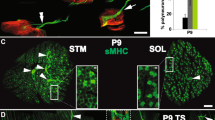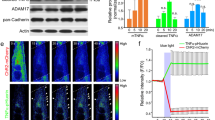Abstract
AFTER transection of a motor nerve, the severed part of the axon undergoes progressive changes known as Wallerian degeneration. But before the degenerating axon loses its ability to conduct action potentials, function and structure of the motor nerve terminals are impaired and neuromuscular transmission fails1. Several workers have noted that this failure occurs at a time which depends on the length of the degenerating nerve segment2,3. This communication describes experiments which make it possible to relate quantitatively the length of the degenerating axon to the time at which neuromuscular transmission fails.
This is a preview of subscription content, access via your institution
Access options
Subscribe to this journal
Receive 51 print issues and online access
$199.00 per year
only $3.90 per issue
Buy this article
- Purchase on Springer Link
- Instant access to full article PDF
Prices may be subject to local taxes which are calculated during checkout
Similar content being viewed by others
References
Titeca, J., Arch. Internat. Physiol., 41, 1 (1935). Rosenblueth, A., The Transmission of Nerve Impulses at Neuroeffector Junctions and Peripheral Synapses, 191 (Wiley and Sons, New York, 1950).
Eyzaguirre, C., Espildora, J., and Luco, J. V., Acta Physiol. Lat-Amer., 2, 213 (1952). Birks, R., Katz, B., and Miledi, R., J. Physiol., 150, 145 (1960).
Luco, J. V., and Eyzaguirre, C., J. Neurophysiol., 18, 65 (1955).
Author information
Authors and Affiliations
Rights and permissions
About this article
Cite this article
SLATER, C. Time Course of Failure of Neuromuscular Transmission after Motor Nerve Section. Nature 209, 305–306 (1966). https://doi.org/10.1038/209305b0
Issue Date:
DOI: https://doi.org/10.1038/209305b0
This article is cited by
-
Skin innervation and its effects on the epidermis
Journal of Biomedical Science (1997)
-
Effect of nerve length and temperature on the induction of action potentials in denervated slow muscle fibres of the frog
Pfl�gers Archiv European Journal of Physiology (1977)
-
Early membrane depolarization of the fast mammalian muscle after denervation
Pfl�gers Archiv European Journal of Physiology (1971)
Comments
By submitting a comment you agree to abide by our Terms and Community Guidelines. If you find something abusive or that does not comply with our terms or guidelines please flag it as inappropriate.



